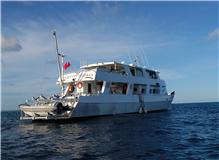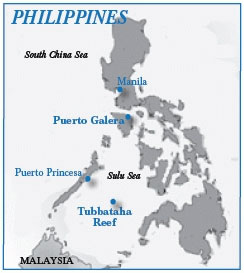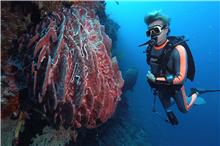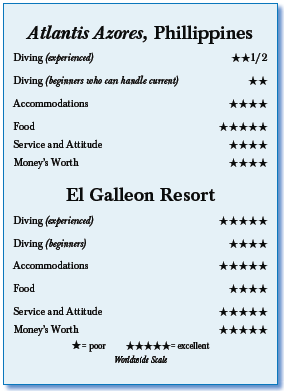Atlantis Azores, PhilippinesContents of this Issue: How Much Post-Dive Activity is Too Much? Bahamas Sharks Threatened by Seafood Exporter’s Expansion Is the Lionfish Really a Threat? Round ‘Em Up: Lionfish Derbies The Coral is Fine at Wakatobi, But Elsewhere... Diving with Erectile Dysfunction Editorial Office: Ben Davison Publisher and Editor Undercurrent 3020 Bridgeway, Suite 102 Sausalito, CA 94965 fantastic liveaboard but only fair diving at Tubbataha Reef, El Galleon good from the October, 2010 issue of Undercurrent
Dear Fellow Diver: When the captain opened the dive deck of the 107-footlong Atlantis Azores, it was time to see whether diving on the remote Tubbataha Reef would live up to its billing. After our 12-hour, open ocean steam from Puerto Princesa, we had anchored for the night on the southern end of the North atoll. Scott, our boyish, stocky American captain, explained that this would provide more shelter than the South atoll from the prevailing winds and chop. It was time to dive. I’d chosen this itinerary because of the promise it held to see lots of big stuff. There wasn’t a lot of information to be found on Tubbataha before I booked the trip. No entries in Undercurrent(I should have seen that as a warning), but glowing reviews on TripAdvisor.com, in Asian Diver and a website called “Dive Happy” described squadrons of sharks, jacks and possibly manta rays. So after backrolling off the skiff with the five other divers on board, I descended down the steep wall known as Amos (AH-moce) looking for that big stuff. Well, there was big stuff all right, but not what I was hoping for. Huge sea fans and even larger barrel sponges sprang from the wall but their effect was diminished by the sparseness of healthy corals and large fields of dead, broken, branching coral. It looked like a monochrome beige ghost town. “Well,” I thought, “it’s a check-out dive, so chalk it up.”
But dive two, on another section of Amos, was much the same: big sponges and coral, with the addition of small numbers of typical Pacific denizens like Moorish Idols, butterflyfish and triggerfish, and more fields of broken corals. By the time I surfaced after our third dive (we did four to five dives a day), from a site called Wall Street, I was concerned. You guessed it: fields of dead corals. I did spot a couple of small white-tip sharks but not the thriving schools I’d expected. I posed next to a few sponges for staff photographer Randy, but because I’d taken plenty of sponge and fan shots already and there was not a single anemone fish to capture on my Nikon, I was frustrated.
But I certainly had no complaints about the boat. The Atlantis Azores, built in 1989 and refitted in 2005, is operated by the folks who run the two Atlantis resorts in the Philippines, at Puerto Galera and Dumaguete. This was my eighth liveaboard trip, and I found the Atlantis to be among the best. It’s spotless; every inch of carpeting looks brand new and covers not only the floors but also the walls of the cabins and the salon. There’s abundant oak wood paneling, window trim and balustrades. My cabin, #6, is a bit tight for double occupancy but plenty roomy for me. Beautifully appointed with flawless wood trim, a double lower and single upper bunk with good reading lights and a large vanity that housed a sink, it provided plenty of storage in three large drawers, a lower storage cabinet and plenty of under-bunk space. No closet, but I used a spare towel bar near the cabin door to hang clothes. There was a large medicine cabinet above with a mirrored door. The air conditioning was easily adjustable. The ensuite head had a full-size marine commode and separate shower stall. And the food? Worthy of a four-star restaurant. Chef Norman, in toque and checkered pants, made multiple main courses, each a special creation with elegant presentation. Each day began with rolls, fresh fruits, yogurts, cereals, etc. Full breakfast followed the first dive, with plates of French toast, potatoes, rolls, bacon, sausages, and eggs with a choice of preparation. Lunches were multi-course hot meals, with all manner of meats, fish, pastas and salads. Juices, iced tea and coffee were always available. There was also a never-ending variety of hearty “snacks,” ranging from just-baked cookies to barbecued chicken wings or shrimp. Dinners ranged from the Philippines’ ubiquitous pork to beef to pasta and piles of skewered, barbecued shrimp. Bowls of rice accompanied lunch and dinner, along with delicious soups, wildly varied in ingredients and flavors. Local vegetables made an appearance at most meals, and some form of salad appeared at every repast. A number of dishes had some heat, and there were always bland choices to be had. Norman’s desserts were religious experiences, like an incredible chocolate mousse with a gelled mango topping. The portions served were often enough for twice the number of us guests. The staff balanced the formality and grace of a Michelin Guide server with the friendliness of your local bartender. At least two crew members were always ready to help make the meal pleasurable, offering drinks or picking up a dropped napkin. With only six of us onboard, personal attention was exceptional. My fellow passengers were as pleasant and entertaining as the crew, though considerably more varied. A young Englishman was on leave from a research ship taking seismic readings in the North Sea. A friendly duo from New York State was the only couple on board, he a web entrepreneur and she a private jet hostess who once served soup to a grateful Henry Kissinger. The 1968 U.S. Olympic gymnastics team had one of our passengers as a member, now a college gymnastics coach. And there was a weathered, gregarious, 66-year-old Dutchman who spends months each year in the Philippines. Thankfully, the diving got more interesting as the week progressed, though never near the picture painted in other print and online publications. At the Delsan wreck on the South Atoll spun a vortex of hundreds of small barracuda, amid which a gray reef shark patrolled and even swam right up to my camera. The site was sunlit and thick with healthy branching corals. A gold-spotted eel peeked out of its hole, and a small hawksbill turtle swam by. During the safety stop, a large school of jacks circled. A bumphead wrasse was a highlight of the Malayan wreck site, which also featured a friendly hawksbill and lots of reef fish. Triggerfish City, heavily populated with aggressive titans patrolling the “cone of danger” above their hollowed-out, circular sand nests, was home to a large gray reef shark lazing under a ledge, and a few juvenile to mid-sized white tips, black tips and grays. A nudibranch drought was broken by a sighting of a gigantic maroon nudi that still remains unidentified. This was also the site of our only night dive, more of a twilight dive. Those titans were especially aggressive. We were told to face our tormentors, who often went well beyond their nests to harass us. As the dusk deepened, an octopus made a grand entrance. At first deep burgundy in color, it quickly transformed to sandy beige, matching the surrounding sea floor. It changed shape from squished ball to fully splayed array of tentacles. Back on the dive deck, we were greeted with steaming mugs of hot chocolate. On most dives, I spotted turtles, most unafraid of divers, as well as clown triggers and surgeonfish. Among the many butterflyfish, most abundant were pyramids, their glowing yellow bodies marked with the stark white shapes for which they’re named. The corals, when healthy, were all in shades of tan, without the color seen in Fiji, for example. Water hovered around 86 degrees, and on one dive, I saw 90 degrees register on my Suunto. Visibility averaged 75 feet or better. Current varied tremendously. One dive featured two changes of current within the hour. Some were strong, but never fierce; probably around one knot. Skiff diving was the order of the day. Crew brought everyone’s gear on board the mother ship only for tank filling, then immediately returned it to the skiff until each diver’s last dive of the day. A bit off-putting was that Nitrox readings could not be checked by divers; they were taken by crew and then entered into a logbook which each diver had to sign to acknowledge the mixture before diving. (It’s ironic that the training video used for Nitrox instruction on board emphasized repeatedly the need for divers to personally check their Nitrox mixes before diving!) But overall, the operation was safety conscious, well organized and well run.
After a thorough briefing, we carried masks and fins, and boarded the skiff while crew handled the cameras. BCs and tanks were stacked in the front of the skiff, while weight belts and integrated pockets remained on the floor until suiting up. Cameras were kept in the stern, under the watchful eye of the skiff driver. After short rides to sites, we suited up on the gunwales with help from the divemaster and boat driver, then a countdown and a backroll over the side. Descents and ascents were conducted as a group. A sturdy, portable ladder made it easy to ascend, after removing and handing up camera, weights, BC and fins. Dives were limited to 100 feet and lasted one hour on the dot. They were overseen by divemasters, one with the divers who was on constant lookout for exotic marine life, and one on the skiff, watching bubbles. The crew was a delight, almost always genuinely smiling and laughing, with Ambo being the most impish and rambunctious. That all but Captain Scott and Randy, the free-spirited American photo pro, were Filipinos posed no language or other barriers. In fact, a crew member named J.R. was a dead ringer for our current Commander in Chief. Captain Scott, and soon the rest of us, referred to him as “Obama.” On the last day of diving before the steam home,a head cold had spread through our group and kept me from diving, so the crew began rinsing my gear for departure. I retired to the salon to watch The Hurt Locker with the crew, many of whom had their first respite in a week of dawn-to-dusk duties.
On my last night, I retired to my cabin for the overnight steam back to Puerto Princessa. Nestled in my cozy bunk, I thought that the Atlantis Azores is a spectacular liveaboard in every way. I just wished the diving at Tubbataha Reef had lived up to the delights of the boat. The irony was that my next stop, the El Galleon Resort in Puerto Galera, provided some of the better diving I’ve seen in the Pacific. It gives Papua New Guinea, the Solomons and, at times, even Raja Ampat a run for their money, especially for the small stuff. I had been advised by my fellow Dutch diver to “put your macro lens on the camera and leave it there.” Exactly one minute into my first dive, right off the resort’s dock at a site called Small Lalaguna, I was shown a blue ribbon eel waving in the breeze. Five minutes later, an ornate ghost pipefish. Dive #2, at Sinandigan Wall, was a nudibranch fetishist’s peep show. It seemed as though nudis were crawling along every stretch of this beautiful wall and surrounding coral heads. Just about every kind of Chromidoris and Nembrotha were on display, as well as countless other varieties. Three huge frogfish stole the show on the decomposing Sabang wrecks, with multiple seahorses, hermit crabs and another ornate ghost pipefish in the seagrass. A night dive on the same site brought us into what I call the Land of the Royal Urchins, where dozens of the spectacular black-spiked and royal purple-patterned creatures scoured the sea floor,reminding me of Star Trek’s “tribbles.” The crowning glory of dive sites, though, at least from the perspective of reef beauty, was Verde Island. This two-tank morning trip, 40 minutes from the resort, ranks among the best sites I’ve dived in the world. It’s actually two seamounts off the coast of the eponymous island, each topping out about 35 feet below the surface. It’s hard to describe the utter riot of corals, fish, invertebrates and colors that blanket every inch of these sites. The first dive turned up every kind of nudibranch in the book, as well as loads of anemone fish, lionfish, scorpionfish, lobsters, an octopus, lots of eels, a barramundi and a beautiful juvenile batfish lazily swimming tight patterns under a coral ledge. There is current to contend with on the narrower of the two pinnacles, including a fairly fierce downcurrent at a point that is the convergence of two streams of water flowing around the seamount. As luck would have it, I had disconnected my autoinflator for this dive because it was leaking air on the boat. As I approached the point, I found my Suunto Cobra’s depth readings plummeting from 80 feet to 97 feet. Inhaling a gust of gas from my primary, removing it from my mouth, inserting the inflator and exhaling proved to be too lengthy a process to counter the downcurrent. To my amazement, divemaster Larry appeared from above, grabbed my tank yoke and gave me a huge boost upward and out of the current. I was amazed and grateful, to say the least. I thoroughly enjoyed the diving, the resort and the staff of the El Galleon, one of the most efficiently run operations I’ve experienced. Through deft management of their dive boats, they managed to make an overbooked resort of some 60 divers seem like a liveaboard. And the fare was half that of the Atlantis Azores. I’ll certainly consider a return trip there. -- D.L.
|

I want to get all the stories! Tell me how I can become an Undercurrent Online Member and get online access to all the articles of Undercurrent as well as thousands of first hand reports on dive operations world-wide
| Home | Online Members Area | My Account |
Login
|
Join
|
| Travel Index |
Dive Resort & Liveaboard Reviews
|
Featured Reports
|
Recent
Issues
|
Back Issues
|
|
Dive Gear
Index
|
Health/Safety Index
|
Environment & Misc.
Index
|
Seasonal Planner
|
Blogs
|
Free Articles
|
Book Picks
|
News
|
|
Special Offers
|
RSS
|
FAQ
|
About Us
|
Contact Us
|
Links
|
3020 Bridgeway, Ste 102, Sausalito, Ca 94965
All rights reserved.


 Dive four, at Southpark, sent me into near
depression. The only diversion was an eagle ray
off in the blue. Back on the skiff, when our
divemaster, Jess, asked the typical “Good dive?” I
answered, “Nope. I have to be honest, I’m pretty
disappointed.” Jess just looked down at his feet.
Dive four, at Southpark, sent me into near
depression. The only diversion was an eagle ray
off in the blue. Back on the skiff, when our
divemaster, Jess, asked the typical “Good dive?” I
answered, “Nope. I have to be honest, I’m pretty
disappointed.” Jess just looked down at his feet. 
 The salon holds comfortable couches,
an entertainment system with a
large flat screen and an assortment of
digital audio and video devices, and a
comprehensive collection of marine ID
books. The lower portion of the salon
houses two long tables that seat 10
each. A long, two-tiered charging station
is built into one wall, with the
top row for 110 volts and the bottom
for 220. The covered dive deck is spacious
and spotless, with a three-tiered
camera table complete with compressed
air hoses. The diver stations have
large storage bins under the benches.
Two large rinse tanks are dedicated to
wetsuits and cameras respectively. I
found the two strong, hot-water showers,
always stocked with soap and shampoo, to
be a better venue than my cramped cabin
shower. The upper sun deck had under
cover a large table with padded benches,
a hot tub and an open area with chaise
lounges.
The salon holds comfortable couches,
an entertainment system with a
large flat screen and an assortment of
digital audio and video devices, and a
comprehensive collection of marine ID
books. The lower portion of the salon
houses two long tables that seat 10
each. A long, two-tiered charging station
is built into one wall, with the
top row for 110 volts and the bottom
for 220. The covered dive deck is spacious
and spotless, with a three-tiered
camera table complete with compressed
air hoses. The diver stations have
large storage bins under the benches.
Two large rinse tanks are dedicated to
wetsuits and cameras respectively. I
found the two strong, hot-water showers,
always stocked with soap and shampoo, to
be a better venue than my cramped cabin
shower. The upper sun deck had under
cover a large table with padded benches,
a hot tub and an open area with chaise
lounges. Diver’s Compass: Weather permits diving at Tubbataha from mid-March
to mid-June; the Atlantis Azores spends time in other Philippines
locales, including the Dumaguete area, described as the “new Lembeh”
for its profusion of exotic critters . . . The seven-night Tubbataha
trip runs $2,595, twin share, with additional charges for Nitrox
($125) and marine park fees ($75); juices, sodas, beer and wine are
included in the package . . . I booked my trip through Island Dreams
travel agency’s very knowledgeable Tina Robinette (
Diver’s Compass: Weather permits diving at Tubbataha from mid-March
to mid-June; the Atlantis Azores spends time in other Philippines
locales, including the Dumaguete area, described as the “new Lembeh”
for its profusion of exotic critters . . . The seven-night Tubbataha
trip runs $2,595, twin share, with additional charges for Nitrox
($125) and marine park fees ($75); juices, sodas, beer and wine are
included in the package . . . I booked my trip through Island Dreams
travel agency’s very knowledgeable Tina Robinette (